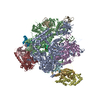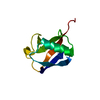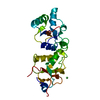[English] 日本語
 Yorodumi
Yorodumi- EMDB-6340: Electron cryo-microscopy of a BRCA1-RNAPII transcriptional complex -
+ Open data
Open data
- Basic information
Basic information
| Entry | Database: EMDB / ID: EMD-6340 | |||||||||
|---|---|---|---|---|---|---|---|---|---|---|
| Title | Electron cryo-microscopy of a BRCA1-RNAPII transcriptional complex | |||||||||
 Map data Map data | Reconstruction of BRCA1-RNAPII transcriptional complexes derived from human breast cancer cells | |||||||||
 Sample Sample |
| |||||||||
 Keywords Keywords | transcription / DNA repair / cancer / mRNA / tumor suppressor / ubiquitin ligase | |||||||||
| Function / homology |  Function and homology information Function and homology informationnegative regulation of mRNA 3'-end processing / histone H2AK127 ubiquitin ligase activity / histone H2AK129 ubiquitin ligase activity / Defective DNA double strand break response due to BRCA1 loss of function / Defective DNA double strand break response due to BARD1 loss of function / BRCA1-BARD1 complex / BRCA1-B complex / BRCA1-A complex / BRCA1-C complex / microfibril binding ...negative regulation of mRNA 3'-end processing / histone H2AK127 ubiquitin ligase activity / histone H2AK129 ubiquitin ligase activity / Defective DNA double strand break response due to BRCA1 loss of function / Defective DNA double strand break response due to BARD1 loss of function / BRCA1-BARD1 complex / BRCA1-B complex / BRCA1-A complex / BRCA1-C complex / microfibril binding / negative regulation of centriole replication / sex-chromosome dosage compensation / random inactivation of X chromosome / ubiquitin-modified histone reader activity / chordate embryonic development / cellular response to indole-3-methanol / gamma-tubulin ring complex / negative regulation of intracellular estrogen receptor signaling pathway / nuclear ubiquitin ligase complex / DNA strand resection involved in replication fork processing / negative regulation of fatty acid biosynthetic process / homologous recombination / Regulation of MITF-M-dependent genes involved in DNA replication, damage repair and senescence / tissue homeostasis / protein K6-linked ubiquitination / regulation of phosphorylation / lateral element / Impaired BRCA2 binding to PALB2 / regulation of DNA damage checkpoint / XY body / mitotic G2/M transition checkpoint / negative regulation of protein export from nucleus / RNA polymerase binding / DNA repair complex / DNA damage tolerance / centrosome cycle / Abortive elongation of HIV-1 transcript in the absence of Tat / FGFR2 alternative splicing / MicroRNA (miRNA) biogenesis / Homologous DNA Pairing and Strand Exchange / Defective homologous recombination repair (HRR) due to BRCA1 loss of function / Defective HDR through Homologous Recombination Repair (HRR) due to PALB2 loss of BRCA1 binding function / Defective HDR through Homologous Recombination Repair (HRR) due to PALB2 loss of BRCA2/RAD51/RAD51C binding function / Resolution of D-loop Structures through Synthesis-Dependent Strand Annealing (SDSA) / Viral Messenger RNA Synthesis / Resolution of D-loop Structures through Holliday Junction Intermediates / Signaling by FGFR2 IIIa TM / intracellular membraneless organelle / HDR through Single Strand Annealing (SSA) / response to ionizing radiation / negative regulation of gene expression via chromosomal CpG island methylation / Impaired BRCA2 binding to RAD51 / RNA Pol II CTD phosphorylation and interaction with CE during HIV infection / RNA Pol II CTD phosphorylation and interaction with CE / HIV Transcription Initiation / RNA Polymerase II HIV Promoter Escape / Transcription of the HIV genome / RNA Polymerase II Promoter Escape / RNA Polymerase II Transcription Pre-Initiation And Promoter Opening / RNA Polymerase II Transcription Initiation / RNA Polymerase II Transcription Initiation And Promoter Clearance / Formation of the Early Elongation Complex / Formation of the HIV-1 Early Elongation Complex / mRNA Capping / Transcriptional Regulation by E2F6 / mitotic G2 DNA damage checkpoint signaling / mRNA Splicing - Minor Pathway / PIWI-interacting RNA (piRNA) biogenesis / negative regulation of cell cycle / Processing of Capped Intron-Containing Pre-mRNA / negative regulation of reactive oxygen species metabolic process / Presynaptic phase of homologous DNA pairing and strand exchange / positive regulation of vascular endothelial growth factor production / Pausing and recovery of Tat-mediated HIV elongation / Tat-mediated HIV elongation arrest and recovery / RNA polymerase II transcribes snRNA genes / HIV elongation arrest and recovery / Pausing and recovery of HIV elongation / ubiquitin ligase complex / Tat-mediated elongation of the HIV-1 transcript / Formation of HIV-1 elongation complex containing HIV-1 Tat / SUMOylation of DNA damage response and repair proteins / regulation of DNA repair / negative regulation of extrinsic apoptotic signaling pathway via death domain receptors / Formation of HIV elongation complex in the absence of HIV Tat / RNA polymerase II, core complex / protein autoubiquitination / RNA Polymerase II Transcription Elongation / Formation of RNA Pol II elongation complex / Maturation of protein E / Maturation of protein E / ER Quality Control Compartment (ERQC) / Myoclonic epilepsy of Lafora / RNA Polymerase II Pre-transcription Events / FLT3 signaling by CBL mutants / IRAK2 mediated activation of TAK1 complex / Prevention of phagosomal-lysosomal fusion / Alpha-protein kinase 1 signaling pathway / Glycogen synthesis / IRAK1 recruits IKK complex Similarity search - Function | |||||||||
| Biological species |  Homo sapiens (human) Homo sapiens (human) | |||||||||
| Method | single particle reconstruction / cryo EM / negative staining / Resolution: 22.0 Å | |||||||||
 Authors Authors | Gilmore BL / Winton CE / Demmert AC / Tanner JR / Bowman S / Karageorge V / Patel K / Sheng Z / Kelly DF | |||||||||
 Citation Citation | Journal: Nat Struct Mol Biol / Year: 2012 Title: Architecture of the RNA polymerase II preinitiation complex and mechanism of ATP-dependent promoter opening. Authors: Sebastian Grünberg / Linda Warfield / Steven Hahn /  Abstract: Yeast RNA polymerase II (Pol II) general transcription factor TFIIE and the TFIIH subunit Ssl2 (yeast ortholog of mammalian XPB) function in the transition of the preinitiation complex (PIC) to the ...Yeast RNA polymerase II (Pol II) general transcription factor TFIIE and the TFIIH subunit Ssl2 (yeast ortholog of mammalian XPB) function in the transition of the preinitiation complex (PIC) to the open complex. We show that the three TFIIE winged-helix (WH) domains form a heterodimer, with the Tfa1 (TFIIEα) WH binding the Pol II clamp and the Tfa2 (TFIIEβ) tandem WH domain encircling promoter DNA that becomes single-stranded in the open complex. Ssl2 lies adjacent to TFIIE, enclosing downstream promoter DNA. Unlike previous proposals, comparison of the PIC and open-complex models strongly suggests that Ssl2 promotes DNA opening by functioning as a double-stranded-DNA translocase, feeding 15 base pairs into the Pol II cleft. Right-handed threading of DNA through the Ssl2 binding groove, combined with the fixed position of upstream promoter DNA, leads to DNA unwinding and the open state. #5:  Journal: Journal of Scientific Reports Journal: Journal of Scientific ReportsTitle: A Molecular Toolkit to Visualize Native Protein Assemblies in the Context of the Human Disease Authors: Gilmore BL / Winton CE / Demmert AC / Tanner JR / Bowman S / Karageorge V / Patel K / Sheng Z / Kelly DF | |||||||||
| History |
|
- Structure visualization
Structure visualization
| Movie |
 Movie viewer Movie viewer |
|---|---|
| Structure viewer | EM map:  SurfView SurfView Molmil Molmil Jmol/JSmol Jmol/JSmol |
| Supplemental images |
- Downloads & links
Downloads & links
-EMDB archive
| Map data |  emd_6340.map.gz emd_6340.map.gz | 283.4 KB |  EMDB map data format EMDB map data format | |
|---|---|---|---|---|
| Header (meta data) |  emd-6340-v30.xml emd-6340-v30.xml emd-6340.xml emd-6340.xml | 23.9 KB 23.9 KB | Display Display |  EMDB header EMDB header |
| Images |  400_6340.gif 400_6340.gif 80_6340.gif 80_6340.gif | 54.3 KB 4.2 KB | ||
| Archive directory |  http://ftp.pdbj.org/pub/emdb/structures/EMD-6340 http://ftp.pdbj.org/pub/emdb/structures/EMD-6340 ftp://ftp.pdbj.org/pub/emdb/structures/EMD-6340 ftp://ftp.pdbj.org/pub/emdb/structures/EMD-6340 | HTTPS FTP |
-Validation report
| Summary document |  emd_6340_validation.pdf.gz emd_6340_validation.pdf.gz | 78.3 KB | Display |  EMDB validaton report EMDB validaton report |
|---|---|---|---|---|
| Full document |  emd_6340_full_validation.pdf.gz emd_6340_full_validation.pdf.gz | 77.4 KB | Display | |
| Data in XML |  emd_6340_validation.xml.gz emd_6340_validation.xml.gz | 493 B | Display | |
| Arichive directory |  https://ftp.pdbj.org/pub/emdb/validation_reports/EMD-6340 https://ftp.pdbj.org/pub/emdb/validation_reports/EMD-6340 ftp://ftp.pdbj.org/pub/emdb/validation_reports/EMD-6340 ftp://ftp.pdbj.org/pub/emdb/validation_reports/EMD-6340 | HTTPS FTP |
-Related structure data
| Similar structure data |
|---|
- Links
Links
| EMDB pages |  EMDB (EBI/PDBe) / EMDB (EBI/PDBe) /  EMDataResource EMDataResource |
|---|---|
| Related items in Molecule of the Month |
- Map
Map
| File |  Download / File: emd_6340.map.gz / Format: CCP4 / Size: 825.2 KB / Type: IMAGE STORED AS FLOATING POINT NUMBER (4 BYTES) Download / File: emd_6340.map.gz / Format: CCP4 / Size: 825.2 KB / Type: IMAGE STORED AS FLOATING POINT NUMBER (4 BYTES) | ||||||||||||||||||||||||||||||||||||||||||||||||||||||||||||||||||||
|---|---|---|---|---|---|---|---|---|---|---|---|---|---|---|---|---|---|---|---|---|---|---|---|---|---|---|---|---|---|---|---|---|---|---|---|---|---|---|---|---|---|---|---|---|---|---|---|---|---|---|---|---|---|---|---|---|---|---|---|---|---|---|---|---|---|---|---|---|---|
| Annotation | Reconstruction of BRCA1-RNAPII transcriptional complexes derived from human breast cancer cells | ||||||||||||||||||||||||||||||||||||||||||||||||||||||||||||||||||||
| Projections & slices | Image control
Images are generated by Spider. | ||||||||||||||||||||||||||||||||||||||||||||||||||||||||||||||||||||
| Voxel size | X=Y=Z: 5.5 Å | ||||||||||||||||||||||||||||||||||||||||||||||||||||||||||||||||||||
| Density |
| ||||||||||||||||||||||||||||||||||||||||||||||||||||||||||||||||||||
| Symmetry | Space group: 1 | ||||||||||||||||||||||||||||||||||||||||||||||||||||||||||||||||||||
| Details | EMDB XML:
CCP4 map header:
| ||||||||||||||||||||||||||||||||||||||||||||||||||||||||||||||||||||
-Supplemental data
- Sample components
Sample components
-Entire : BRCA1-RNAP II transcriptional assemblies isolated from hereditary...
| Entire | Name: BRCA1-RNAP II transcriptional assemblies isolated from hereditary breast cancer cells |
|---|---|
| Components |
|
-Supramolecule #1000: BRCA1-RNAP II transcriptional assemblies isolated from hereditary...
| Supramolecule | Name: BRCA1-RNAP II transcriptional assemblies isolated from hereditary breast cancer cells type: sample / ID: 1000 Oligomeric state: one BRCA1 molecule binds to one polymerase complex Number unique components: 5 |
|---|---|
| Molecular weight | Theoretical: 800 KDa |
-Macromolecule #1: RNA Polyermase II core
| Macromolecule | Name: RNA Polyermase II core / type: protein_or_peptide / ID: 1 / Name.synonym: Pol2 / Number of copies: 1 / Recombinant expression: No / Database: NCBI |
|---|---|
| Source (natural) | Organism:  Homo sapiens (human) / synonym: human / Tissue: breast / Cell: tumor / Organelle: nucleus / Location in cell: nucleus Homo sapiens (human) / synonym: human / Tissue: breast / Cell: tumor / Organelle: nucleus / Location in cell: nucleus |
| Molecular weight | Theoretical: 500 KDa |
| Sequence | UniProtKB: DNA-directed RNA polymerase II subunit RPB1 |
-Macromolecule #2: BRCA1
| Macromolecule | Name: BRCA1 / type: protein_or_peptide / ID: 2 Details: BRCA1 was attached to tunable microchips using antibodies against the BRCA1 C-terminal domain Number of copies: 1 / Oligomeric state: monomer / Recombinant expression: No / Database: NCBI |
|---|---|
| Source (natural) | Organism:  Homo sapiens (human) / synonym: human / Tissue: breast / Cell: tumor / Organelle: nucleus / Location in cell: nucleus Homo sapiens (human) / synonym: human / Tissue: breast / Cell: tumor / Organelle: nucleus / Location in cell: nucleus |
| Molecular weight | Theoretical: 200 KDa |
| Sequence | UniProtKB: Breast cancer type 1 susceptibility protein |
-Macromolecule #3: BARD1
| Macromolecule | Name: BARD1 / type: protein_or_peptide / ID: 3 / Number of copies: 1 / Oligomeric state: monomer / Recombinant expression: No / Database: NCBI |
|---|---|
| Source (natural) | Organism:  Homo sapiens (human) / synonym: human / Tissue: breast / Cell: tumor / Organelle: nucleus / Location in cell: nucleus Homo sapiens (human) / synonym: human / Tissue: breast / Cell: tumor / Organelle: nucleus / Location in cell: nucleus |
| Molecular weight | Theoretical: 87 KDa |
| Sequence | UniProtKB: BRCA1-associated RING domain protein 1 |
-Macromolecule #4: Ubiqutin
| Macromolecule | Name: Ubiqutin / type: protein_or_peptide / ID: 4 / Number of copies: 2 / Oligomeric state: monomer / Recombinant expression: No / Database: NCBI |
|---|---|
| Source (natural) | Organism:  Homo sapiens (human) / synonym: human / Tissue: breast / Cell: tumor / Organelle: nucleus / Location in cell: nucleus Homo sapiens (human) / synonym: human / Tissue: breast / Cell: tumor / Organelle: nucleus / Location in cell: nucleus |
| Molecular weight | Theoretical: 8 KDa |
| Sequence | UniProtKB: Polyubiquitin-C |
-Macromolecule #5: DNA
| Macromolecule | Name: DNA / type: dna / ID: 5 / Classification: DNA / Structure: DOUBLE HELIX / Synthetic?: No |
|---|---|
| Source (natural) | Organism:  Homo sapiens (human) / synonym: human Homo sapiens (human) / synonym: human |
-Experimental details
-Structure determination
| Method | negative staining, cryo EM |
|---|---|
 Processing Processing | single particle reconstruction |
| Aggregation state | particle |
- Sample preparation
Sample preparation
| Buffer | pH: 7.5 / Details: 50 mM HEPES, 150 mM NaCl, 10 mM MgCl2, 10 mM CaCl2 |
|---|---|
| Staining | Type: NEGATIVE Details: Protein complexes were adsorbed to antibody-decorated microchips for 2 minutes and stained with 1% uranyl formate for 1 minute. |
| Grid | Details: SiN microchips with TEM windows coated with 25% Ni-NTA functionalized lipid monolayers |
| Vitrification | Cryogen name: ETHANE / Chamber humidity: 90 % / Chamber temperature: 93 K / Instrument: GATAN CRYOPLUNGE 3 Method: Microchips were blotted for ~8 seconds using one-sided blotting. |
- Electron microscopy
Electron microscopy
| Microscope | FEI TECNAI SPIRIT |
|---|---|
| Temperature | Min: 83 K |
| Alignment procedure | Legacy - Astigmatism: Objective lens astigmatism was corrected at high magnification. |
| Details | low-dose illumination |
| Date | Mar 8, 2013 |
| Image recording | Category: CCD / Film or detector model: FEI EAGLE (2k x 2k) / Digitization - Sampling interval: 30 µm / Number real images: 50 / Average electron dose: 5 e/Å2 |
| Electron beam | Acceleration voltage: 120 kV / Electron source: LAB6 |
| Electron optics | Calibrated magnification: 54500 / Illumination mode: FLOOD BEAM / Imaging mode: BRIGHT FIELD / Cs: 2 mm / Nominal defocus max: -3.0 µm / Nominal defocus min: -1.0 µm / Nominal magnification: 50000 |
| Sample stage | Specimen holder model: GATAN LIQUID NITROGEN |
| Experimental equipment | 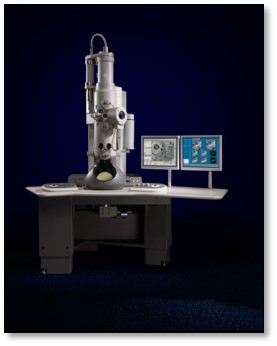 Model: Tecnai Spirit / Image courtesy: FEI Company |
- Image processing
Image processing
| Details | The particles were selected using an automatic selection program. |
|---|---|
| CTF correction | Details: Each particle |
| Final reconstruction | Algorithm: OTHER / Resolution.type: BY AUTHOR / Resolution: 22.0 Å / Resolution method: OTHER / Software - Name: RELION / Number images used: 22000 |
| Final two d classification | Number classes: 5 |
-Atomic model buiding 1
| Initial model | PDB ID: Chain - #0 - Chain ID: A / Chain - #1 - Chain ID: B / Chain - #2 - Chain ID: C / Chain - #3 - Chain ID: D / Chain - #4 - Chain ID: E / Chain - #5 - Chain ID: F / Chain - #6 - Chain ID: G / Chain - #7 - Chain ID: H / Chain - #8 - Chain ID: I / Chain - #9 - Chain ID: J / Chain - #10 - Chain ID: K / Chain - #11 - Chain ID: L |
|---|---|
| Software | Name:  Chimera Chimera |
| Details | The domains were separately fitted by manual docking using the Chimera software package. |
| Refinement | Space: REAL / Protocol: RIGID BODY FIT |
-Atomic model buiding 2
| Initial model | PDB ID: Chain - Chain ID: A |
|---|---|
| Software | Name:  Chimera Chimera |
| Details | The domains were separately fitted by manual docking using the Chimera software package. |
| Refinement | Space: REAL / Protocol: RIGID BODY FIT |
-Atomic model buiding 3
| Initial model | PDB ID: Chain - Chain ID: A |
|---|---|
| Software | Name:  Chimera Chimera |
| Details | The domains were separately fitted by manual docking using the Chimera software package. |
| Refinement | Space: REAL / Protocol: RIGID BODY FIT |
-Atomic model buiding 4
| Initial model | PDB ID: Chain - #0 - Chain ID: A / Chain - #1 - Chain ID: B |
|---|---|
| Software | Name:  Chimera Chimera |
| Details | The domains were separately fitted by manual docking using the Chimera software package. |
| Refinement | Space: REAL / Protocol: RIGID BODY FIT |
 Movie
Movie Controller
Controller



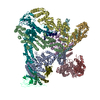





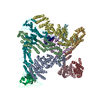































 Z (Sec.)
Z (Sec.) Y (Row.)
Y (Row.) X (Col.)
X (Col.)





















